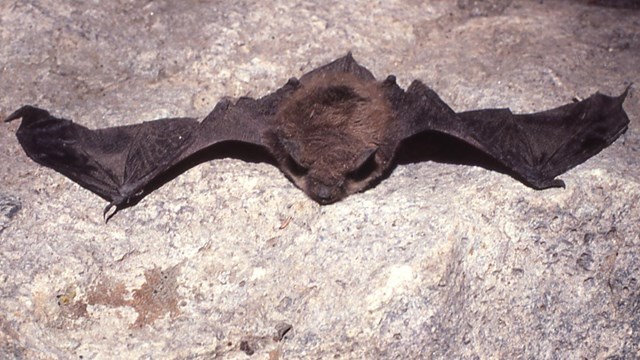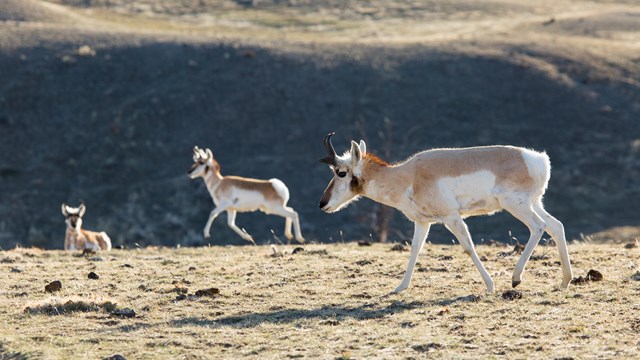|
Visit our keyboard shortcuts docs for details
Resource education film on bats in the Greater Yellowstone Ecosystem. Bats are the only mammals capable of sustained, flapping flight, which has given rise to a great diversity of species throughout the world. All bat species that have been documented in Yellowstone National Park are all insectivores (insect-eaters). To support the energy demands for flight, insectivorous bats must eat a large number of insects. Nursing females may consume their own body weight in food each night during the summer. In temperate environments, bats mate in late summer or autumn, just before entering into hibernation for the winter. During spring and summer, bats tend to be highly localized near sources of food, water, and roosting structures. They roost in natural habitats, including thermally heated caves, as well as in bridges, buildings, and other human structures, which can lead to conflicts with human use and historical preservation plans. Bats are considered indicator species because their distribution and population trends provide valuable information about habitat quality and the overall health of an ecosystem. PopulationBat monitoring efforts using acoustic surveys at 36 point stationsand mist-net captures have identified the following thirteen bat species in Yellowstone National Park:
The goal of bat monitoring in Yellowstone is to establish baseline data on the distribution, activity, and habitat use by bat species and identify impacts to bat populations from the disease whitenose syndrome (WNS). The fungal pathogen Pseudogymnoascus destructans, which causes WNS, has been responsible for declines as high as 99% in wintering bat populations, leading to regional extinctions of several species in northeastern North America. Bats cannot recover quickly, if at all, from these substantial population declines because most species that are vulnerable to WNS rear only a single pup per female each year. As of 2024, WNS has been confirmed in 9 Canadian provinces and 40 states, including Montana and Wyoming. However, monitoring efforts in Yellowstone have not yet detected Pd in the park. The Yellowstone wildlife health program tested 99 samples for Pd from bat skin swabs and guano samples in 2024 with consistent Pd negative results. It is important to identify the location of maternity roosts and hibernacula, locations that are used for reproduction and over-winter survival, respectively. Female bats captured with mist-nets and fitted with radio-transmitters have helped to identify buildings that serve as maternity roosts (where females raise young) for little brown bats. Research suggests that access to building attics within Yellowstone National Park is critical for their reproductive success and the long-term conservation. HabitatRoosts provide bats with protection from weather and predators and bats in greater Yellowstone use both natural habitats and man-made structures including bridges and abandoned mines. Research suggests that that the thermal conditions in maternity roosts are important for the reproductive success of little brown bats. Roosts allow young bats to maximize their growth rate, wean, and begin to fly and forage earlier because they use less energy to stay warm. Bats are long-lived (10–30 years) and show fidelity to maternal roost sites where they have successfully raised young. For this reason, bats will continually return to attics of park buildings, which can lead to conflicts with human use and historical preservation plans. The presence of other bats in Yellowstone is probably restricted by the limited location of suitable roosts and/or the distribution of insect prey. Most western bat species migrate short distances from their summer roosts to their winter hibernating locations. However, bat activity has been documented within Yellowstone during every month of the year, which suggests multiple bat species remain within Yellowstone over winter. Some species migrate long distances to areas where temperature and insect populations support continued activity. These species may not hibernate. In greater Yellowstone, the hoary bat likely migrates south for the winter. Physical AdaptationsBats with long, narrow wings (e.g., the hoary bat) are fast but less maneuverable fliers that typically forage in open areas. Bats with short, broad wings (e.g., Townsend’s big-eared bat) are slower but more agile and typically forage in forested areas or along the edge of vegetation. A few Yellowstone bats, such as long-eared myotis, pallid bat, and Townsend’s big-eared bat can glean insects off the surface of vegetation, and have wing shapes that enable them to hover and carry larger prey. Bats use an echolocation system to navigate and find food in the dark. Many species produce pulses of high frequency ultrasonic sound and listen for the returning echoes. The echoes provide bats with a sonic picture of the environment which includes the movement of prey. High frequency calls are less likely to alert predators and are effective for locating prey, although some moths have developed organs on their abdomens capable of detecting such calls. Bats also use lower frequency calls (often audible to humans) to communicate with each other. To conserve energy, bats can enter a state of torpor, which allows them to lower their metabolic rate and body temperature. Most bat species in greater Yellowstone use torpor during winter months and periods in spring and summer with cold nightly temperatures and reduced food availability. At rest, bats roost head down, which makes them less vulnerable to predators and facilitates flight. A bat can remain upside down for months because of cavities in its cranium that pool blood and other fluids away from the brain and an arrangement of ligaments and leg muscles that enables them to hang passively from their perch while sleeping. ResourcesAdams, R. A. 2003. Bats of the Rocky Mountain West: natural history, ecology, and conservation. Boulder, CO: University Press of Colorado. Altringham, J.D. 1996. Bats: biology and behavior. Oxford: Oxford University Press. Bogan, M.A., and K. Geluso. 1999. Bat roosts and historic structures on National Park Service lands in the Rocky Mountain Region. Final report submitted to the National Park Service, Denver, CO. USGS Midcontinent Ecological Science Center, University of New Mexico, Albuquerque, NM. Fenton, M.B., and R.M.R. Barclay. 1980. Myotis lucifigus. Mammalian Species Publication No. 142. American Society of Mammalogists. 142:1–8. Johnson, J.S., J.J. Treanor, M.J. Lacki, et al. 2016. Migratory and winter activity of bats in Yellowstone National Park. Journal of Mammalogy. Advance online publication, 7 November 2016 (DOI 10.1093/jmammal/gyw175). Keinath, D.A. 2007. Yellowstone’s world of bats: Taking in- ventory of Yellowstone’s night life. Yellowstone Science 15(3):3–13. 
Bats Subject Site
Millions of bats live in national parks. In fact, more than 50 unique species of bats live in national parks! 
Mammals
All of the park's hoofed mammals migrate across the park to find the best plant growth. |
Last updated: April 18, 2025
